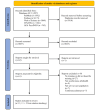Training Service Users in the Use of Telehealth: Scoping Review
- PMID: 39083789
- PMCID: PMC11325118
- DOI: 10.2196/57586
Training Service Users in the Use of Telehealth: Scoping Review
Abstract
Background: The use of telehealth has rapidly increased, yet some populations may be disproportionally excluded from accessing and using this modality of care. Training service users in telehealth may increase accessibility for certain groups. The extent and nature of these training activities have not been explored.
Objective: The objective of this scoping review is to identify and describe activities for training service users in the use of telehealth.
Methods: Five databases (MEDLINE [via PubMed], Embase, CINAHL, PsycINFO, and Web of Science) were searched in June 2023. Studies that described activities to train service users in the use of synchronous telehealth consultations were eligible for inclusion. Studies that focused on health care professional education were excluded. Papers were limited to those published in the English language. The review followed the Joanna Briggs Institute guidelines for scoping reviews and was reported in line with the PRISMA-ScR (Preferred Reporting Items for Systematic Reviews and Meta-Analyses Extension for Scoping Reviews) guidelines. Titles and abstracts were screened by 1 reviewer (EG). Full texts were screened by 2 reviewers (EG and JH or SC). Data extraction was guided by the research question.
Results: The search identified 8087 unique publications. In total, 13 studies met the inclusion criteria. Telehealth training was commonly described as once-off preparatory phone calls to service users before a telehealth visit, facilitated primarily by student volunteers, and accompanied by written instructions. The training content included guidance on how to download and install software, troubleshoot technical issues, and adjust device settings. Older adults were the most common target population for the training. All but 1 of the studies were conducted during the COVID-19 pandemic. Overall, training was feasible and well-received by service users, and studies mostly reported increased rates of video visits following training. There was limited and mixed evidence that training improved participants' competency with telehealth.
Conclusions: The review mapped the literature on training activities for service users in telehealth. The common features of telehealth training for service users included once-off preparatory phone calls on the technical elements of telehealth, targeted at older adults. Key issues for consideration include the need for co-designed training and improving the broader digital skills of service users. There is a need for further studies to evaluate the outcomes of telehealth training activities in geographically diverse areas.
Keywords: PRISMA-ScR; Preferred Reporting Items for Systematic Reviews and Meta-Analyses Extension for Scoping Reviews; caregiver; caregivers; consultation; consultations; data extraction; digital divide; digital literacy; education; geriatric; geriatrics; gerontology; health care professional; health care professionals; modality of care; older adult; older adults; phone; phones; review; scoping review; telehealth; telemonitoring; training; training service; user; users; video consultations.
©Emer Galvin, Shane Desselle, Blánaid Gavin, Fiona McNicholas, Shane Cullinan, John Hayden. Originally published in the Journal of Medical Internet Research (https://www.jmir.org), 31.07.2024.
Conflict of interest statement
Conflicts of Interest: None declared.
Figures
References
-
- Digital health in the European region: the ongoing journey to commitment and transformation. World Health Organization. 2023. [2024-07-01]. https://www.who.int/andorra/publications/m/item/digital-health-in-the-wh... .
-
- Hong JS, Sheriff R, Smith K, Tomlinson A, Saad F, Smith T, Engelthaler T, Phiri P, Henshall C, Ede R, Denis M, Mitter P, D'Agostino A, Cerveri G, Tomassi S, Rathod S, Broughton N, Marlowe K, Geddes J, Cipriani A. Impact of COVID-19 on telepsychiatry at the service and individual patient level across two UK NHS mental health trusts. Evid Based Ment Health. 2021;24(4):161–166. doi: 10.1136/ebmental-2021-300287. https://air.unimi.it/handle/2434/898818 ebmental-2021-300287 - DOI - PMC - PubMed
-
- Sugarman DE, Horvitz LE, Greenfield SF, Busch AB. Clinicians' perceptions of rapid scale-up of telehealth services in outpatient mental health treatment. Telemed J E Health. 2021 Dec;27(12):1399–1408. doi: 10.1089/tmj.2020.0481. https://europepmc.org/abstract/MED/33600272 - DOI - PMC - PubMed
-
- Roberts ET, Mehrotra A. Assessment of disparities in digital access among Medicare beneficiaries and implications for telemedicine. JAMA Intern Med. 2020;180(10):1386–1389. doi: 10.1001/jamainternmed.2020.2666. https://europepmc.org/abstract/MED/32744601 2768771 - DOI - PMC - PubMed
-
- Nouri S, Khoong EC, Lyles CR, Karliner L. Addressing equity in telemedicine for chronic disease management during the Covid-19 pandemic. NEJM Catalyst. 2020;1(3):1–13. doi: 10.1056/CAT.20.0123. https://catalyst.nejm.org/doi/full/10.1056/CAT.20.0123 - DOI - DOI
Publication types
MeSH terms
LinkOut - more resources
Full Text Sources
Medical
Miscellaneous



